Voyager 1

Voyager 1 was launched by NASA on September 5, 1977, from Cape Canaveral, Florida, aboard a Titan IIIE–Centaur rocket. Its primary mission was to conduct detailed studies of Jupiter and Saturn, including their moons, rings, and magnetic fields. The spacecraft took advantage of a rare planetary alignment that occurs once every 176 years, enabling a gravity-assisted trajectory to conserve fuel and increase its velocity.
Voyager 1 is equipped with a suite of scientific instruments designed for planetary studies and space environment analysis. These include imaging systems, magnetometers, plasma detectors, and cosmic ray sensors. The spacecraft is powered by a radioisotope thermoelectric generator (RTG), which converts heat from the radioactive decay of plutonium-238 into electricity. Voyager 1 measures approximately 3.7 meters in diameter, with a high-gain antenna for communication and a mass of about 722 kilograms (1,592 pounds) at launch.
During its flybys of Jupiter in 1979, Voyager 1 captured unprecedented images of the planet’s Great Red Spot and detailed views of its cloud systems. It provided the first close-up images of Jupiter’s moons, including Io, where it discovered active volcanoes—the first ever observed beyond Earth. This groundbreaking discovery reshaped our understanding of geological activity in the solar system.
At Saturn in 1980, Voyager 1 revealed intricate details of the planet’s ring system, including new ringlets and mysterious radial features known as “spokes.” The spacecraft also closely studied Saturn’s largest moon, Titan, whose thick atmosphere intrigued scientists and hinted at the presence of organic compounds.
Communication with Voyager 1 is maintained through NASA’s Deep Space Network (DSN), which transmits commands and receives data from the spacecraft. The vast distance—currently over 15 billion miles (24 billion kilometers) from Earth—means that signals take more than 22 hours to travel one way. Despite its diminishing power supply, Voyager 1 continues to send back data about cosmic rays, magnetic fields, and other phenomena in interstellar space.
After completing its primary mission, Voyager 1 continued its journey outward. In 1990, at a distance of about 6 billion kilometers (3.7 billion miles) from Earth, it turned its cameras back to capture the iconic “Pale Blue Dot” image. This photograph, showing Earth as a tiny speck suspended in a sunbeam, underscored the fragility and uniqueness of our planet.
On August 25, 2012, Voyager 1 officially entered interstellar space when it crossed the heliopause—the boundary where the Sun’s influence ends, and the interstellar medium begins. It became the first human-made object to do so, marking a historic milestone in space exploration. The spacecraft’s instruments detected a significant increase in cosmic rays and a decrease in solar particles, confirming its passage into this uncharted region.
Voyager 1 carries the Golden Record, a 12-inch gold-plated copper disc containing sounds and images selected to portray the diversity of life and culture on Earth. Curated by a team led by astronomer Carl Sagan, the record includes greetings in 55 languages, natural sounds such as thunder and birdsong, and music ranging from Bach to Chuck Berry. This time capsule was designed to communicate the essence of humanity to any extraterrestrial civilization that might encounter the spacecraft.
Voyager 1 Mission
Primary Mission of Voyager 1
Voyager 1 is a space probe launched by NASA on September 5, 1977, as part of the Voyager program. Its primary goal was to conduct an in-depth exploration of the outer planets, specifically Jupiter and Saturn, their moons, and their unique systems. The mission aimed to expand our understanding of the solar system’s largest planets and their environments. Key objectives included:
- Studying Jupiter and Saturn: Voyager 1 was tasked with analyzing the atmospheres, magnetospheres, and ring systems of Jupiter and Saturn to gain insights into their composition, structure, and dynamics.
- Investigating Major Moons: It aimed to conduct close-up studies of significant moons, including Io (known for its active volcanism) and Europa (a candidate for subsurface oceans) at Jupiter, as well as Titan at Saturn, which has a thick atmosphere rich in organic compounds.
- Exploring the Interplanetary Medium: The probe was designed to measure the properties of cosmic rays, magnetic fields, and charged particles in the space between planets.
Extended Mission of Voyager 1
After successfully completing its primary mission, Voyager 1 continued its journey outward, becoming the first spacecraft to enter interstellar space in August 2012. In this phase, its focus shifted to studying the interstellar medium—the region beyond the influence of the Sun’s solar wind. It continues to transmit valuable data back to Earth, contributing to our understanding of the boundaries of the solar system and beyond.
Voyager 1 also carries the Golden Record, a time capsule containing sounds, images, and messages from Earth, intended to communicate the story of humanity to any extraterrestrial life that might encounter it.
Achievements of Voyager 1
1. Exploration of Jupiter (1979)
- Detailed Observations: Voyager 1 captured high-resolution images of Jupiter, revealing details of its atmosphere, including its Great Red Spot, a massive storm system.
- Moons Discovery: It provided the first close-up images of Jupiter’s major moons, including:
- Io: Revealed active volcanism for the first time on another celestial body.
- Europa: Indicated a smooth, icy surface, suggesting the possibility of a subsurface ocean.
- Magnetosphere Analysis: Measured Jupiter’s strong magnetic field and its interactions with surrounding particles.
2. Exploration of Saturn (1980)
- Atmosphere Studies: Voyager 1 analyzed Saturn’s atmosphere, uncovering data on its composition, structure, and weather patterns.
- Ring System: It provided unprecedented images of Saturn’s rings, showing their intricate structure and detecting new ringlets.
- Titan’s Atmosphere: Voyager 1 conducted a close flyby of Titan, confirming its dense nitrogen-rich atmosphere, which is crucial for studying prebiotic chemistry.
3. First Human-Made Object in Interstellar Space (2012)
- Crossing the Heliosphere: On August 25, 2012, Voyager 1 became the first spacecraft to enter interstellar space, traveling beyond the Sun’s influence into the interstellar medium.
- Interstellar Studies: It has been sending back data on cosmic rays, interstellar plasma, and magnetic fields, providing insights into the environment between stars.
4. Longevity and Distance
- Record-Holder: Voyager 1 is the most distant human-made object from Earth, traveling over 14 billion miles (as of 2024).
- Operational Duration: It continues to send data after more than 47 years, showcasing the durability and ingenuity of its design.
5. The Golden Record
- Voyager 1 carries a Golden Record, a time capsule with sounds, images, and messages representing Earth’s diversity and culture. It serves as a symbolic gesture of humanity’s hope to connect with extraterrestrial civilizations.
6. Pioneering Science and Technology
- Voyager 1’s instruments and findings have influenced countless scientific studies, advancing our knowledge of planetary science, the interstellar medium, and the nature of space travel.
Launch and Trajectory of Voyager 1
The launch and trajectory of Voyager 1 are among the most remarkable achievements in space exploration. Here’s an overview:
Launch of Voyager 1

- Date of Launch: September 5, 1977
- Rocket: Titan IIIE-Centaur
- Launch Site: Cape Canaveral Air Force Station, Florida
- Mission Goal: Initially, to explore the outer planets—Jupiter and Saturn—and their moons, and eventually to venture into interstellar space.
Voyager 1 was launched 16 days after its twin, Voyager 2. Although it was launched second, it was placed on a faster trajectory, enabling it to overtake Voyager 2 and reach Jupiter and Saturn first.
Trajectory Highlights of Voyager 1
- Jupiter Flyby:
- Date: March 5, 1979
- Closest Approach: Approximately 349,000 kilometers (217,000 miles).
- Key Discoveries:
- Detailed images of Jupiter’s atmosphere and its Great Red Spot.
- Discovery of volcanic activity on Io, the first observed beyond Earth.
- Exploration of Jupiter’s ring system and magnetosphere.
- Saturn Flyby:
- Date: November 12, 1980
- Closest Approach: About 124,000 kilometers (77,000 miles).
- Key Discoveries:
- Detailed views of Saturn’s rings, including the discovery of new ring structures.
- Observations of Saturn’s largest moon, Titan, which has a thick atmosphere of nitrogen and methane.
- Post-Saturn Trajectory:
- After the Saturn encounter, Voyager 1 was directed to a trajectory out of the plane of the ecliptic, away from the other planets, to begin its journey toward interstellar space.
Construction of Voyager 1
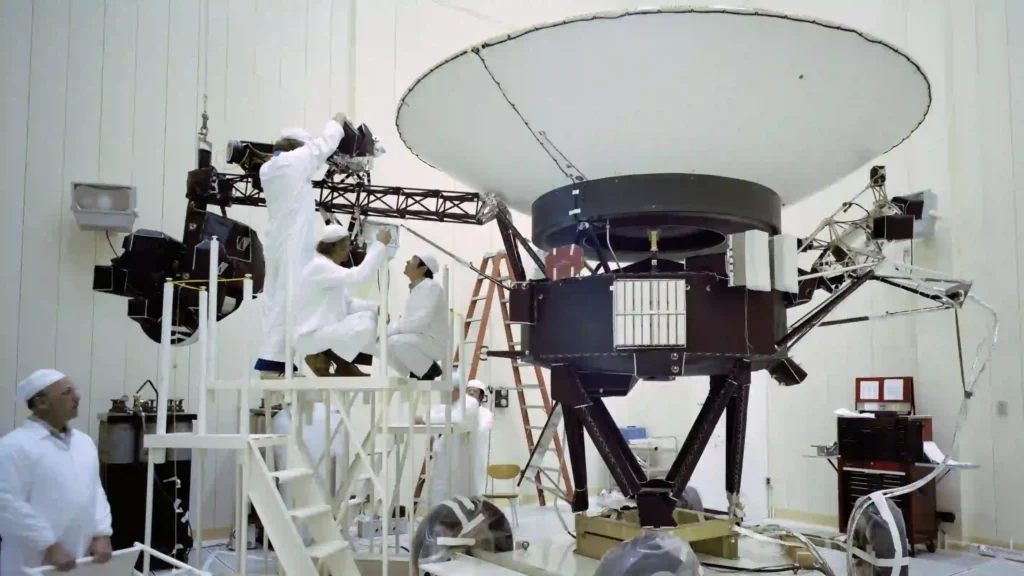
The construction of Voyager 1 was a highly complex and meticulous process, designed to ensure the spacecraft could withstand the harsh environment of space and complete its mission of exploring the outer planets and beyond. Below is a detailed overview of the construction of Voyager 1, highlighting key elements:
1. Structure and Frame
- Main Bus (Spacecraft Frame):
- The spacecraft’s central structure, known as the bus, is a lightweight yet durable frame designed to house all of the components, including scientific instruments, communications systems, and power generators.
- It is built using aluminum and titanium for strength and weight efficiency, ensuring both structural integrity and minimal mass for launch.
- Dimensions:
- Voyager 1 measures approximately 3.7 meters (12 feet) in height with a length of around 2.5 meters (8.5 feet) across its base, including its solar panels and antenna.
- The spacecraft’s high-gain antenna, a 3.7-meter (12-foot) dish, is its largest component and one of the most critical parts of its structure.
2. Power Supply: Radioisotope Thermoelectric Generators (RTGs)
- RTG Design:
- Voyager 1 is powered by three Radioisotope Thermoelectric Generators (RTGs), which convert heat from the decay of plutonium-238 into electrical energy.
- This power system is ideal for deep-space missions where solar power is insufficient due to the vast distance from the Sun. Each RTG produces about 250 watts of electrical power initially, which decreases over time as the plutonium decays.
- Thermal Management:
- The RTGs also serve to keep the spacecraft warm, especially the scientific instruments, in the cold vacuum of space.
- Thermal blankets made of materials like multi-layer insulation (MLI) were used to protect the spacecraft from extreme temperature fluctuations in space.
3. Propulsion and Attitude Control System
- Thrusters:
- Voyager 1 uses hydrazine-based thrusters for small trajectory adjustments and to keep the spacecraft oriented correctly.
- These thrusters are used to adjust the spacecraft’s attitude, allowing the high-gain antenna to always point toward Earth, ensuring continuous communication.
- Star Trackers and Sun Sensors:
- The spacecraft’s attitude is monitored by star trackers, which capture images of distant stars to determine orientation, and sun sensors that help align the spacecraft with the Sun for power and orientation control.
4. Communications System
- High-Gain Antenna (HGA):
- A 3.7-meter (12-foot) parabolic dish that acts as the primary communication link between Voyager 1 and Earth.
- Constructed from a lightweight mesh of aluminum, this antenna sends and receives data through the Deep Space Network (DSN). It is mounted on the spacecraft with an articulation system, allowing it to maintain proper orientation for communication.
- Low-Gain Antennas:
- Voyager 1 also includes smaller low-gain antennas, used during early mission phases or in situations when the high-gain antenna is not properly oriented.
5. Scientific Instruments
The spacecraft was equipped with a wide range of scientific instruments housed within its main body. These included:
- Imaging Science System (ISS):
- A pair of cameras, the wide-angle and narrow-angle, capable of capturing detailed images of planets, moons, and other celestial objects.
- Plasma and Particle Detectors:
- Instruments like the Plasma Science Experiment (PLS), Low-Energy Charged Particles (LECP), and Cosmic Ray System (CRS) were designed to measure radiation, charged particles, and plasma in space.
- Infrared and Ultraviolet Spectrometers:
- Instruments like IRIS (infrared spectrometer) and UVS (ultraviolet spectrometer) were used to analyze the planets’ atmospheres, surface composition, and radiation.
- Magnetometer (MAG):
- The magnetometer, attached to a boom extending from the spacecraft, measured magnetic fields around Jupiter, Saturn, and the spacecraft’s trajectory.
- Plasma Wave Subsystem (PWS):
- The PWS measured fluctuations in the plasma environment, helping to study the solar wind and interstellar medium.
6. The Golden Record
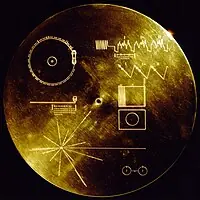
- Construction of the Golden Record:
- Voyager 1 carries a 12-inch gold-plated copper disc, known as the Golden Record, which contains sounds, images, and messages meant to represent Earth’s diversity and culture.
- The disc is mounted on the spacecraft with a stylus to allow for potential playback by extraterrestrial civilizations. It includes greetings in various languages, classical and traditional music, and sounds from nature, such as a human heartbeat and whale songs.
7. Environmental Protection
- Multi-Layer Insulation (MLI):
- Voyager 1’s exterior was covered with MLI blankets to protect sensitive components from extreme temperature variations, space radiation, and micrometeoroid impacts.
- The spacecraft also employed shields to safeguard its instruments and communications system from damage caused by solar radiation and particles.
8. Materials and Durability
- Materials for Longevity:
- The spacecraft was constructed with materials capable of surviving in deep space for decades, including high-strength aluminum, titanium, ceramics, and composite materials for various components.
- The construction aimed to ensure durability, as the mission was expected to last long beyond the reach of traditional spacecraft, eventually operating in interstellar space.
Flybys performed by Voyager 1
During its early mission phase, Voyager 1 performed detailed flybys of Jupiter and Saturn, offering unprecedented insights into these distant worlds and their systems. Here is a comprehensive account of Voyager 1’s flybys:
1. Jupiter Flyby (March 5, 1979)
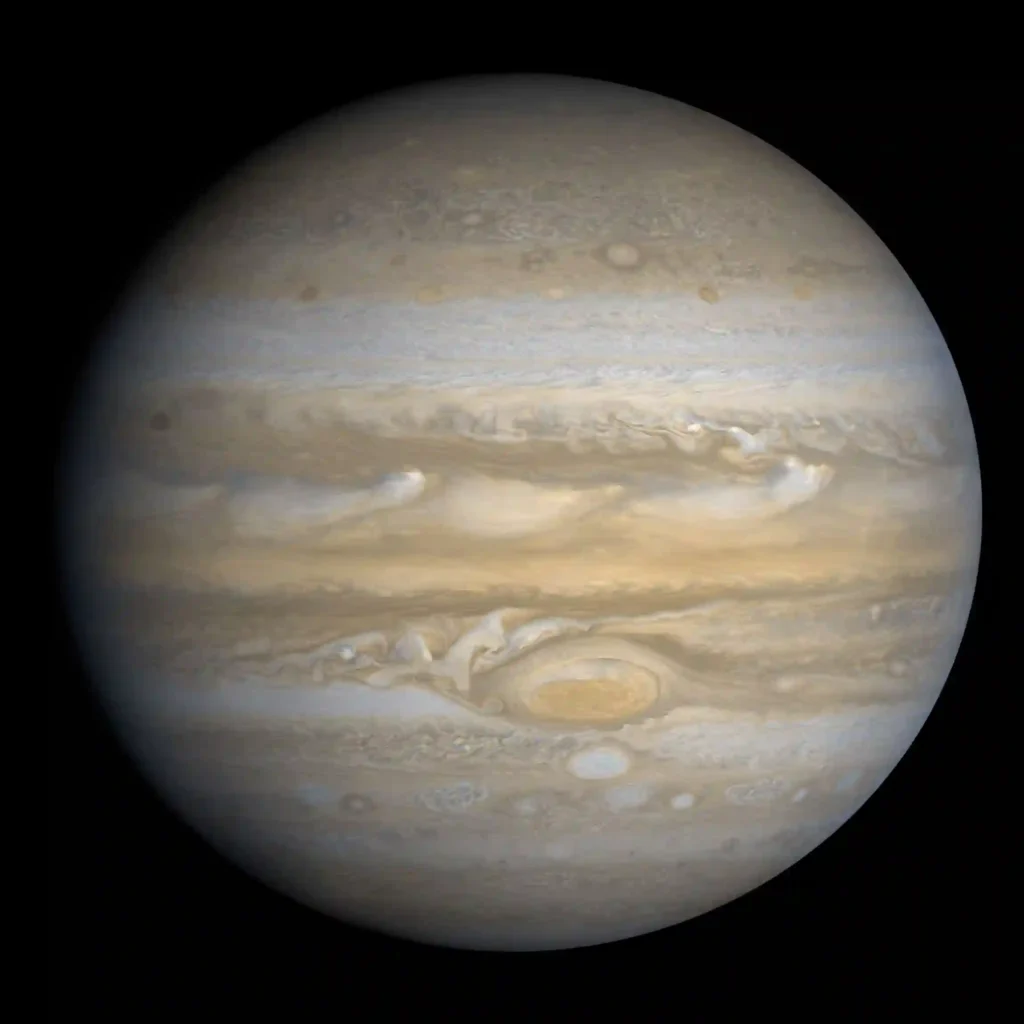
Voyager 1’s encounter with Jupiter marked a groundbreaking moment in planetary exploration, providing an extraordinary wealth of data and images that revolutionized our understanding of the largest planet in the solar system and its diverse moons and rings.
- Closest Approach:
- On March 5, 1979, Voyager 1 came within approximately 349,000 kilometers (217,000 miles) of Jupiter’s cloud tops, allowing for unprecedented close-up observations.
- Key Objectives:
- To study Jupiter’s atmosphere, magnetic field, and radiation belts.
- To investigate the structure and composition of Jupiter’s rings.
- To explore the moons of Jupiter, particularly Io and Europa.
- Major Discoveries:
- Atmospheric Features:
- Voyager 1 captured detailed images of Jupiter’s atmosphere, showcasing its complex weather systems. The spacecraft revealed intricate cloud patterns, lightning activity, and convective storms.
- The Great Red Spot, a massive storm larger than Earth, was observed in high resolution, highlighting its swirling motion and interactions with nearby atmospheric features.
- Planetary Rings:
- Voyager 1 discovered a thin, faint ring system around Jupiter. Composed of small, dark particles, these rings are nearly invisible from Earth and represent a stark contrast to the prominent rings of Saturn.
- Volcanism on Io:
- The most groundbreaking discovery of the flyby was the detection of active volcanoes on Io, one of Jupiter’s largest moons. Images showed volcanic plumes rising hundreds of kilometers above the surface, driven by intense tidal heating caused by gravitational interactions with Jupiter and other moons.
- This was the first time active volcanism was observed on a celestial body other than Earth, reshaping theories about geologic activity in the solar system.
- Europa’s Surface:
- High-resolution images of Europa revealed a smooth, icy surface with a network of cracks and ridges. The absence of large craters suggested a geologically young surface, likely shaped by a subsurface ocean beneath the ice.
- Magnetosphere:
- Voyager 1 provided data on Jupiter’s immense magnetosphere, which is the largest and most powerful in the solar system. The spacecraft measured its interaction with the solar wind and its effects on Jupiter’s moons.
- Atmospheric Features:
- Radiation Belts:
- Voyager 1 encountered intense radiation belts around Jupiter, much stronger than those around Earth. These radiation zones posed challenges for spacecraft instrumentation and highlighted the harsh environment near the gas giant.
- Moons:
- In addition to Io and Europa, Voyager 1 studied other Jovian moons, including Ganymede and Callisto. It revealed their diverse surfaces, with Ganymede showing evidence of tectonic activity and Callisto displaying a heavily cratered landscape.
- Imaging Details:
- Voyager 1’s imaging system captured over 18,000 images of Jupiter and its moons during the flyby. These images provided unprecedented views of the Jovian system and remain a cornerstone of planetary science research.
- Scientific Impact:
- The data from Voyager 1’s Jupiter flyby fundamentally altered our understanding of the gas giant and its satellites. It also set the stage for future missions, such as Galileo, Juno, and Europa Clipper, which have continued to investigate Jupiter and its moons.
2. Saturn Flyby (November 12, 1980)
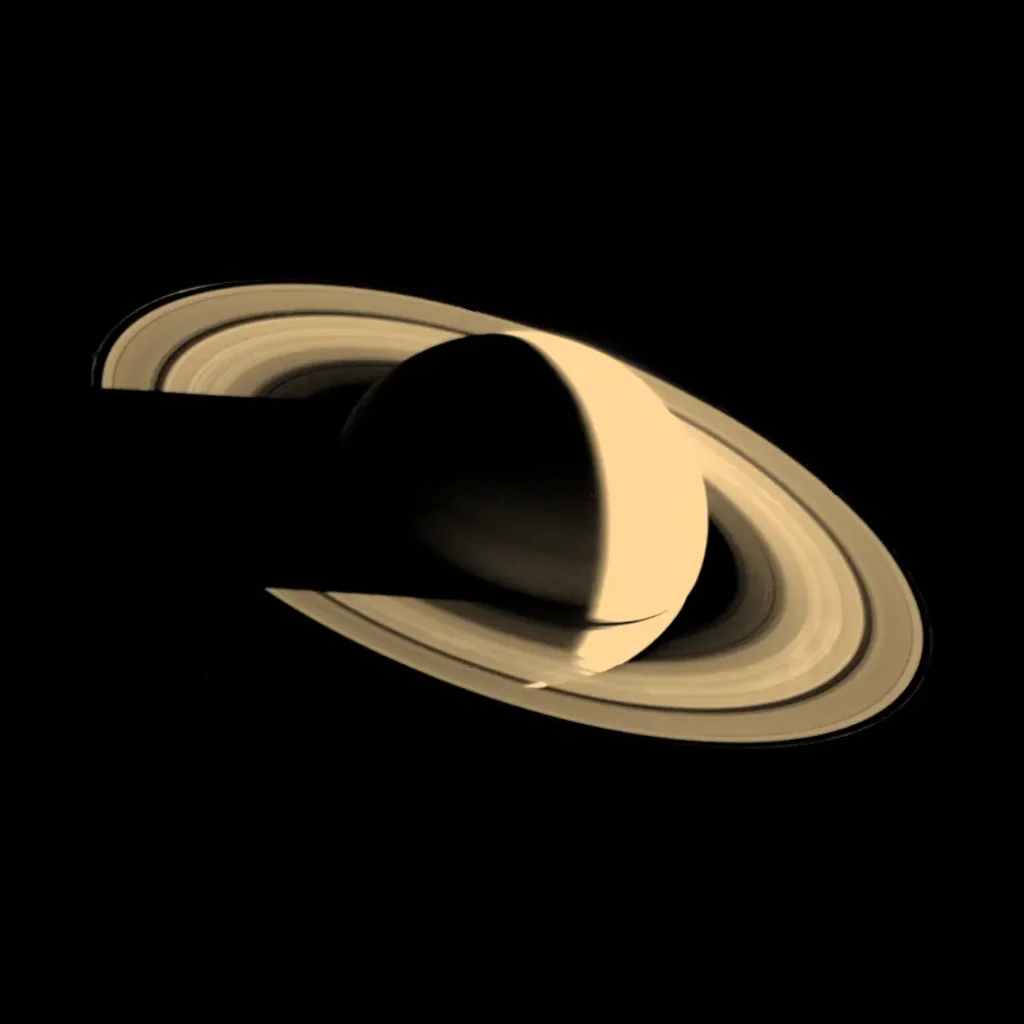
Voyager 1’s encounter with Saturn was another groundbreaking event. The spacecraft approached within 124,000 kilometers (77,000 miles) of Saturn’s cloud tops, capturing detailed images of the planet and its rings.
- Key Discoveries:
- Ring System: Voyager 1 provided high-resolution images of Saturn’s intricate ring system, revealing several new ringlets and gaps. The mission demonstrated that Saturn’s rings are composed of countless particles, ranging in size from tiny grains to large boulders, each orbiting the planet independently.
- Titan’s Atmosphere: Voyager 1 conducted a close flyby of Titan, Saturn’s largest moon. It discovered that Titan has a thick, nitrogen-rich atmosphere with a complex mix of hydrocarbons, including methane and ethane. The data suggested that Titan’s surface might feature liquid hydrocarbon lakes, although direct confirmation would come later from subsequent missions.
- Magnetic Field: Voyager 1 studied Saturn’s magnetic field and its interaction with the solar wind. The data showed that Saturn’s magnetosphere is smaller and less powerful than Jupiter’s but still plays a significant role in shaping the environment around the planet.
Voyager 1’s flyby of Saturn marked the end of its planetary encounters, as it was directed on a trajectory to escape the solar system, unlike its twin, Voyager 2, which continued to Uranus and Neptune.
Exit from Heliosphere

The exit from the heliosphere by Voyager 1 on August 25, 2012, marked a historic moment in space exploration. Here’s a detailed look at this event:
What is the Heliosphere?
The heliosphere is a vast bubble of charged particles and magnetic fields created by the Sun. It encompasses the entire solar system and acts as a protective shield against high-energy cosmic rays from interstellar space.
Key regions of the heliosphere:
- Heliosheath: The outermost layer of the heliosphere, where the solar wind slows and interacts with the interstellar medium.
- Heliopause: The boundary where the solar wind’s influence ends and the interstellar medium begins. This is the “edge” of the heliosphere.
The entry and exit of Voyager 1 to the Heliopause
Voyager 1 spent decades traveling through the solar system and the heliosphere before reaching the heliopause. Key milestones include:
- Termination Shock (2004): Voyager 1 crossed this boundary, where the solar wind abruptly slows down as it begins to interact with the interstellar medium.
- Heliosheath (2004–2012): Voyager 1 traversed this turbulent region filled with heated and compressed solar wind.
Crossing the Heliopause
Voyager 1 crossed the heliopause on August 25, 2012, entering interstellar space. This was confirmed through multiple observations:
- Plasma Wave Measurements:
- Voyager 1 detected a significant increase in the density of charged particles.
- Interstellar plasma is about 40 times denser than the plasma inside the heliosphere, consistent with the characteristics of interstellar space.
- Drop in Solar Particles:
- A dramatic decrease in the detection of particles emitted by the Sun.
- Cosmic Rays:
- Voyager 1 recorded a sharp increase in galactic cosmic rays, which are mostly blocked by the heliosphere.
- Magnetic Field:
- The magnetic field strength changed, although its direction remained similar, indicating proximity to the Sun’s influence even in interstellar space.
Significance of the Event
- First Human-Made Object in Interstellar Space: Voyager 1 became the first spacecraft to leave the heliosphere, entering the region dominated by material from exploded stars rather than our Sun.
- New Data: Voyager 1 provides the only direct measurements of the interstellar medium, offering insights into:
- The density and temperature of interstellar plasma.
- The nature of cosmic rays and magnetic fields beyond the heliosphere.
- Interactions between the heliosphere and the interstellar medium.
Voyager 1 in Interstellar space
Voyager 1, launched by NASA on September 5, 1977, is a spacecraft that has become one of humanity’s most extraordinary achievements. It crossed into interstellar space on August 25, 2012, making it the first human-made object to do so. This milestone means that Voyager 1 exited the heliosphere—the protective bubble of particles and magnetic fields created by the Sun—and entered the space between stars, dominated by the interstellar medium.
Key Facts about Voyager 1 in Interstellar Space:
- Distance from Earth: As of now, Voyager 1 is over 15 billion miles (24 billion kilometers) from Earth, and the distance continues to increase. Radio signals from the spacecraft take over 22 hours to travel one way.
- Scientific Discoveries:
- Voyager 1 detected the plasma density in the interstellar medium, confirming its crossing into this new region of space.
- It studies cosmic rays, magnetic fields, and other properties of interstellar space, providing data about the boundary region where solar and interstellar winds interact.
- Instruments Still Active: Although many of its systems have been turned off to conserve power, a few scientific instruments continue to operate and send back valuable data.
- Power Supply: Voyager 1 is powered by radioisotope thermoelectric generators (RTGs), which are slowly losing power. NASA expects it to continue communicating until around 2025, at which point its power supply will likely no longer support operations.
- Golden Record: Voyager 1 carries a golden record, a time capsule containing sounds and images representing the diversity of life and culture on Earth, intended as a message for any extraterrestrial civilization that might encounter it.
Communication with Voyager 1
1. Communication Systems
Voyager 1 relies on a sophisticated setup of onboard systems and ground-based infrastructure for data transmission.
Onboard Communication Systems
- High-Gain Antenna (HGA):
- A parabolic dish 3.7 meters (12 feet) in diameter, designed to send a focused beam of radio waves toward Earth.
- Ensures that signals remain strong despite the vast distances.
- Radio Transmitter:
- Operates at 23 watts of power.
- Sends data via S-band (uplink) and X-band (downlink) frequencies for efficient communication.
- Data Encoding:
- Information is compressed and encoded before transmission to ensure it survives the journey.
Ground-Based Infrastructure
NASA’s Deep Space Network (DSN) is used to communicate with Voyager 1. It consists of three facilities located strategically around the globe:
- Goldstone, California, USA.
- Madrid, Spain.
- Canberra, Australia.
- Each site has 70-meter (230-foot) dish antennas capable of detecting Voyager’s faint signals.
- The DSN tracks Voyager 1 around the clock to maintain constant contact as Earth rotates.
2. How Communication Works
- Command Uplink:
- NASA sends commands from Earth to Voyager 1 using the DSN.
- Signals travel at the speed of light, taking over 22 hours to reach the spacecraft.
- Telemetry Downlink:
- Voyager 1 transmits scientific data and engineering telemetry back to Earth.
- The DSN receives the faint signals, amplifies them, and decodes the data for analysis.
3. Challenges of Communicating with Voyager 1
Distance:
- Voyager 1 is over 15 billion miles (24 billion kilometers) away.
- Radio signals weaken exponentially with distance. By the time they reach Earth, Voyager’s signals are so weak they are equivalent to a fraction of a quintillionth of a watt.
Signal Delay:
- There is a one-way delay of more than 22 hours, meaning real-time communication is impossible. Engineers must carefully plan commands and wait almost two days for confirmation.
Limited Power Supply:
- Voyager 1 is powered by radioisotope thermoelectric generators (RTGs), which lose power by about 4 watts per year due to the decay of plutonium-238.
- NASA prioritizes essential systems, shutting down non-critical instruments to conserve energy.
Aging Hardware:
- Voyager 1 operates with technology from the 1970s:
- 68 kilobytes of memory (less than a modern smartphone).
- Analog systems susceptible to degradation over decades of operation.
Directional Precision:
- Voyager’s high-gain antenna must remain precisely aligned with Earth for signals to be received.
- The spacecraft uses its Attitude Articulation and Control System (AACS) to adjust its orientation. Malfunctions, like the 2022 telemetry glitch, can complicate communication.
Environmental Factors:
- Cosmic radiation and interstellar plasma can interfere with Voyager’s electronics and signals.
4. Solutions and Mitigations
Deep Space Network Enhancements:
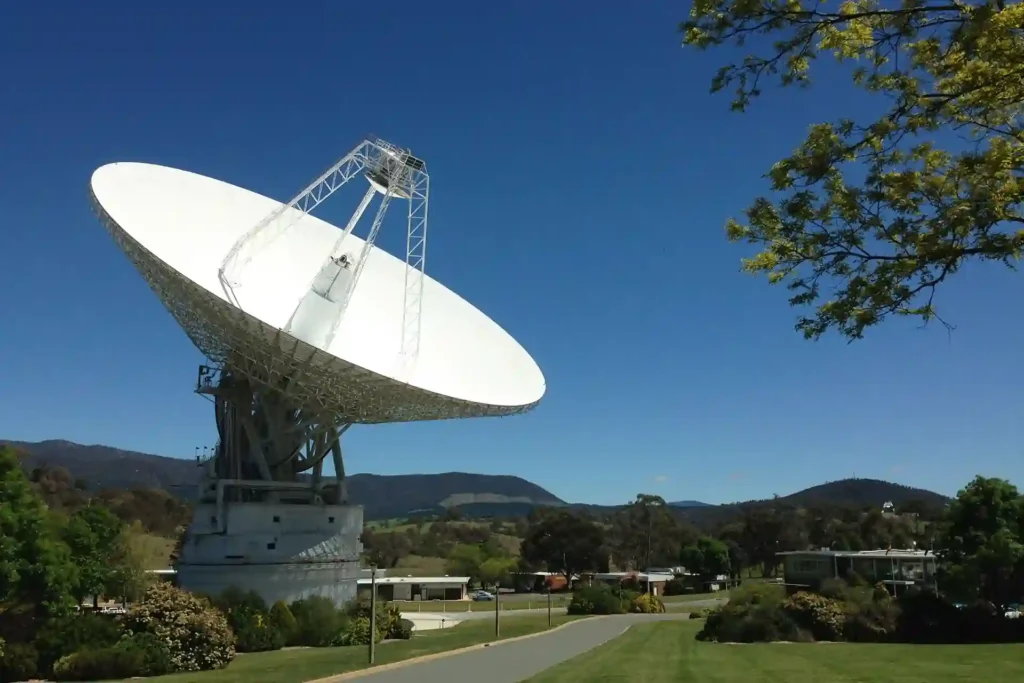
- The DSN has been upgraded with more sensitive receivers and advanced signal processing capabilities.
- Redundant systems ensure uninterrupted communication.
Remote Software Updates:
- Engineers periodically reconfigure Voyager’s systems to optimize its operations and manage hardware issues.
Power Management:
- NASA carefully prioritizes power usage, shutting down non-essential instruments and heaters to extend mission life.
5. Voyager 1’s Remaining Mission
- Communication Window: By 2025, the RTGs will likely no longer provide enough power for Voyager 1 to transmit data.
- Golden Record: Even after communication ends, Voyager 1 will continue its silent journey through interstellar space, carrying humanity’s message to the cosmos.
Communication issues with Voyager 1
Maintaining communication with Voyager 1, currently the most distant human-made object in space, poses several technical and operational challenges. These issues stem from its immense distance, limited power supply, aging technology, and environmental factors. Here’s a detailed breakdown:
1. Distance and Signal Delay
- Current Distance: Voyager 1 is over 15 billion miles (24 billion kilometers) from Earth.
- Signal Travel Time: Radio signals traveling at the speed of light take over 22 hours one way to reach Earth, and an additional 22 hours for a response to be received.
- Impact: Real-time communication is impossible, requiring careful pre-programming of commands and operations.
2. Weak Signal Strength
- The spacecraft’s radio transmitter operates at only about 23 watts—less power than a standard household light bulb.
- By the time the signal reaches Earth, it is extraordinarily weak, equivalent to a fraction of a quintillionth of a watt.
- Solution: NASA’s Deep Space Network (DSN) uses massive 70-meter (230-foot) dish antennas with highly sensitive receivers to detect and amplify these faint signals.
3. Aging Technology
- 1970s Hardware: Voyager 1 operates on technology that is over 45 years old, including an 8-track tape recorder for data storage and only 68 kilobytes of computer memory.
- Challenges:
- Limited computational power and memory restrict the spacecraft’s ability to handle complex tasks.
- Its instruments and systems are prone to degradation due to prolonged exposure to cosmic radiation.
4. Limited Power Supply
- Voyager 1 is powered by radioisotope thermoelectric generators (RTGs), which convert the heat from decaying plutonium-238 into electricity.
- Declining Output: The RTGs lose about 4 watts per year and are expected to stop supporting scientific instruments around 2025.
- Impact on Communication:
- Reduced power affects the strength and reliability of transmitted signals.
- Engineers must prioritize essential systems and turn off non-critical components to conserve power.
5. Interference and Environmental Factors
- Cosmic Radiation: Voyager 1 operates in the harsh interstellar environment, where cosmic radiation can interfere with its electronics and potentially corrupt data transmission.
- Interstellar Plasma: Dense regions of plasma can attenuate radio signals, causing delays or disruptions in communication.
6. Precision and Coordination
- Directional Challenges: The spacecraft’s high-gain antenna must be precisely aligned with Earth for successful communication. Minor deviations can result in loss of signal.
- Manual Adjustments: Adjusting the spacecraft’s orientation requires time and careful planning, further complicated by the signal delay.
Notable Incidents
- 2022 Telemetry Glitch: Voyager 1 experienced a problem with its Attitude Articulation and Control System (AACS), which manages the spacecraft’s orientation. It sent garbled telemetry data back to Earth, though its antenna remained aligned. NASA engineers resolved the issue by reconfiguring onboard systems remotely.
- Intermittent Data Drops: Periodically, cosmic interference or hardware wear can cause brief interruptions in communication, requiring retransmission or data correction.
Overcoming communication challenges with Voyager 1
NASA engineers have implemented various strategies to maintain communication:
- Software Updates: Despite its age, Voyager 1’s software has been updated remotely to optimize performance.
- Deep Space Network Enhancements: The DSN has undergone upgrades to increase sensitivity and accommodate the faint signals.
- Command Redundancy: Commands are sent multiple times to ensure successful reception despite signal degradation.
Future Communication Outlook
- Voyager 1 will likely lose the ability to transmit data back to Earth by 2025 when its RTGs can no longer power the transmitter.
- Even after the loss of communication, Voyager 1 will continue traveling through interstellar space, carrying the Golden Record as a message to potential extraterrestrial life.
Where is Voyager 1 Now?
As of December 23, 2024, Voyager 1 is over 24 billion kilometers (approximately 15 billion miles) from Earth, making it the most distant human-made object. In celestial terms, Voyager 1 is located in the constellation Ophiuchus. Voyager 1 continues its journey through interstellar space, providing invaluable data about this uncharted region.
Despite its vast distance, NASA maintains communication with Voyager 1 via the Deep Space Network (DSN), a global array of large radio antennas. Signals from Voyager 1 take over 22 hours to reach Earth, and the same duration for a response to return, due to the immense distance. Voyager 1’s mission has been extended multiple times, and it continues to send scientific data back to Earth. However, its power supply is diminishing, and it’s anticipated that by around 2025, the spacecraft may no longer be able to power its instruments or communicate with Earth.
Details in the Articles are collected from trusted Sources you can visit Wikipedia and NASA for more details.
